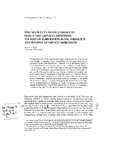YOU NEVER GET A SECOND CHANCE TO MAKE A FIRST (IMPLICIT) IMPRESSION: THE ROLE OF ELABORATION IN THE FORMATION AND REVISION OF IMPLICIT IMPRESSIONS
| dc.contributor.author | Wyer, NA | |
| dc.date.accessioned | 2014-04-03T11:56:10Z | |
| dc.date.accessioned | 2014-04-03T11:56:22Z | |
| dc.date.available | 2014-04-03T11:56:10Z | |
| dc.date.available | 2014-04-03T11:56:22Z | |
| dc.date.issued | 2010-02 | |
| dc.identifier.issn | 0278-016X | |
| dc.identifier.uri | http://hdl.handle.net/10026.1/2947 | |
| dc.description.abstract |
Conditions under which implicit and explicit impressions of an individual may change in response to new information were investigated in two experiments. Participants formed an impression of a target person based on his membership in a social group and, in some conditions, detailed behavioral evidence. Later, half of the participants were given reason to believe that the initial information they had been given was wrong, and that the target actually belonged to a different social group. Implicit and explicit measures of participants' impressions of the target were then collected. Results indicated that, while explicit impressions were effectively corrected in light of new information, implicit impressions continued to reflect initial beliefs (Experiments 1 and 2). However, when given the opportunity to re-examine the original behavioral information, implicit measures also reflected a change in participants' impressions (Experiment 2). The role of elaboration in determining implicit and explicit impression change is discussed. | |
| dc.format.extent | 1-19 | |
| dc.language | EN | |
| dc.language.iso | EN | |
| dc.publisher | GUILFORD PUBLICATIONS INC | |
| dc.relation.replaces | http://hdl.handle.net/10026.1/2946 | |
| dc.relation.replaces | 10026.1/2946 | |
| dc.subject | EXPLICIT ATTITUDE-CHANGE | |
| dc.subject | ASSOCIATION TEST | |
| dc.subject | CATEGORY ACCESSIBILITY | |
| dc.subject | SOCIAL-PERCEPTION | |
| dc.subject | INFORMATION | |
| dc.subject | MALLEABILITY | |
| dc.subject | STEREOTYPES | |
| dc.subject | JUDGMENTS | |
| dc.subject | PREJUDICE | |
| dc.subject | SYSTEMS | |
| dc.title | YOU NEVER GET A SECOND CHANCE TO MAKE A FIRST (IMPLICIT) IMPRESSION: THE ROLE OF ELABORATION IN THE FORMATION AND REVISION OF IMPLICIT IMPRESSIONS | |
| dc.type | journal-article | |
| dc.type | Article | |
| plymouth.issue | 1 | |
| plymouth.volume | 28 | |
| plymouth.publication-status | Published | |
| plymouth.journal | SOC COGNITION | |
| dc.identifier.doi | 10.1521/soco.2010.28.1.1 | |
| plymouth.organisational-group | /Plymouth | |
| plymouth.organisational-group | /Plymouth/Research Groups | |
| plymouth.organisational-group | /Plymouth/Research Groups/Centre for Brain, Cognition and Behaviour (CBCB) | |
| plymouth.organisational-group | /Plymouth/Research Groups/Centre for Brain, Cognition and Behaviour (CBCB)/Cognition | |
| dc.rights.embargoperiod | Not known | |
| rioxxterms.versionofrecord | 10.1521/soco.2010.28.1.1 | |
| rioxxterms.licenseref.uri | http://www.rioxx.net/licenses/all-rights-reserved | |
| rioxxterms.type | Journal Article/Review |


